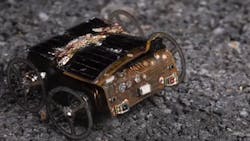Itsy, bitsy, teenie, weenie MilliMobile robot runs on light and radio waves
Bigger isn’t always better, especially when it comes to robotics. While essential for many tasks, especially in the manufacturing space, moving robots require a lot of energy to function, and batteries have numerous drawbacks like a limited lifespan and various environmental issues. But what if you could deploy a micro robot no bigger than a coin to investigate issues at your facility and wirelessly transmit data from attached sensors to help you make more informed decisions?
The MilliMobile is a very small self-driving robot. Unlike other robots that need energy and batteries to function, this small wonder can be powered by surrounding light or radio waves. The MilliMobile was designed to run on harvested power but will also move automatically toward a light source. Developed by researchers at the University of Washington, the MilliMobile is no larger than a penny and comes equipped with an energy harvester and four wheels. The robot has a speed of 30 feet per hour and can navigate a variety of surfaces, including concreate and dirt. The MilliMobile weighs the same as a raisin and can transport three times its weight.
According to Rizwan Choudhury for Interesting Engineering, the researchers used the concept of "intermittent computing" as the inspiration for the MilliMobile. This idea allows a device that only has access to very limited resources to operate slowly, using energy as it becomes available.
In a recent article, New Atlas author Ben Coxworth hypothesized that in the future, collaborative swarms of MilliMobiles may be able to share data wirelessly amongst themselves. In tests, the robot has successfully transmitted data from onboard light, temperature and humidity sensors. With this potential, MilliMobiles could be used to test soil moisture, detect the source of a gas leak, and much more.
In a recent quote, co-lead author Zachary Englhardt, a UW doctoral student in the Allen School, said, “‘Internet of Things’ sensors are usually fixed in specific locations. Our work crosses domains to create robotic sensors that can sample data at multiple points throughout a space to create a more detailed view of its environment, whether that’s a smart farm where the robots are tracking humidity and soil moisture, or a factory where they’re seeking out electromagnetic noise to find equipment malfunctions.”
About the Author
Alexis Gajewski
Senior Content Strategist
Alexis Gajewski has over 15 years of experience in the maintenance, reliability, operations, and manufacturing space. She joined Plant Services in 2008 and works to bring readers the news, insight, and information they need to make the right decisions for their plants. Alexis also authors “The Lighter Side of Manufacturing,” a blog that highlights the fun and innovative advances in the industrial sector.
